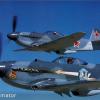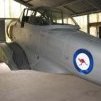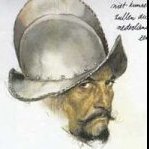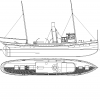MORE HANDBOOKS ARE ON THEIR WAY! We will let you know when they get here.
×
-
Posts
710 -
Joined
-
Last visited
Reputation Activity
-
 aviaamator got a reaction from PeteB in La Jacinthe 1825 by aviaamator - 1:20 - schooner
aviaamator got a reaction from PeteB in La Jacinthe 1825 by aviaamator - 1:20 - schooner
Little progress...
-
 aviaamator reacted to marsalv in Le Gros Ventre by marsalv - FINISHED - 1:48 - POF
aviaamator reacted to marsalv in Le Gros Ventre by marsalv - FINISHED - 1:48 - POF
Thank you guys.4
After several unsuccessful attempts is stern completed. The lower filling parts I had to make four times😡.
-
 aviaamator reacted to marsalv in Le Gros Ventre by marsalv - FINISHED - 1:48 - POF
aviaamator reacted to marsalv in Le Gros Ventre by marsalv - FINISHED - 1:48 - POF
Thanks for comments😉.
Hawse timbers and cant frames - The construction of these parts is more complicated because the individual frames are not glued directly to each other but have a small gap between them. Only the second attempt was successful.
-
 aviaamator reacted to druxey in Le Gros Ventre by marsalv - FINISHED - 1:48 - POF
aviaamator reacted to druxey in Le Gros Ventre by marsalv - FINISHED - 1:48 - POF
Very nicely done, Marsalv. They are tricky little beasts.
-
 aviaamator reacted to Doug McKenzie in Leon by Doug McKenzie - FINISHED - a beautiful little brigantine
aviaamator reacted to Doug McKenzie in Leon by Doug McKenzie - FINISHED - a beautiful little brigantine
The planking is now done (except for one transom plank) and the first pass at fairing is complete. I am reminded of my grandfather who watched ships being built in Maitland, Nova Scotia (also serving in the saw pits). He told me once that his favorite activity was watching the adzmen swarm over the hull after the planking was done. I personally don't find the fairing of the planking to be particularly interesting (the inside planking specifically) and even wondered if I could pay someone to do it! In any event, the lowest transom plank still awaits. The ends of the hull planking need to be cleaned up at the correct angle so that the last transom plank seals the ends of the hull planks. Underhill recommends using 1/4" wide plank (the rest of the transom planks ares 1/8" wide) so that the lowest transom plank will extend past the outer surface of the hull planks. Then, that lowest transom plank can be brought down flush with the outer surface of the hull planks.
On the research side, Jeppe continues to locate useful documents. A newspaper article written about the last days of Leon reveals that "She was taking on too much water even though she had a windmill pump." We have to decide whether to model it or not. This depends on whether we are modelling a relatively new Leon or one with lots of years behind her and so more likely to have significant leaking.
The original Sheer Plan (discussed in the previous posting) also has a curious rectangle in the bow just above the waterline. Jeppe realized that this is a lumber hatch which gives us certainty that she carried lumber - only a possibility before that. This also helps us define the position of the sole of the fo'c'sle since we know that the lumber passed through the fo'c'sle on it's way to the hold
!
-
 aviaamator reacted to Tim Curtis in Leon by Doug McKenzie - FINISHED - a beautiful little brigantine
aviaamator reacted to Tim Curtis in Leon by Doug McKenzie - FINISHED - a beautiful little brigantine
Doug,
Saw this very fine model of the Leon in a maritime model shop called Float a Boat in Melbourne. Took some photos...not great quality. But thought they might be a helpful reference perhaps.
Tim
-
 aviaamator reacted to Doug McKenzie in Leon by Doug McKenzie - FINISHED - a beautiful little brigantine
aviaamator reacted to Doug McKenzie in Leon by Doug McKenzie - FINISHED - a beautiful little brigantine
With this post, I'm beginning a build log for Leon. 302 tons, built in 1880 in Norway, traded until 1915. Model is 1:48, about 2 1/2 ft on deck. Structure is all Swiss Pear, planking - internal and external is Pau Marfin, rail and wale is Indian Rosewood. Much planking and decking will be left off so that the internals will be visible. I just ordered 6 little oil latterns with LEDs that will eventually light up the interior of the hold. Most helpful resources so far are Underhill's Plank-On-Frame Models, Crother's American-Built Packets and Freighters of the 1850s, Tosti's Young America and various forums on this website. Heading to San Francisco shortly to review Ron Cleveland's research material for his model of Leon in the 1970s. Suggestions from anyone who has ideas about how to research the internal construction are more than just welcome, they will be warmly appreciated!
For now the bilge ceiling (meaning the common planks between the keelson and the bilge stringer). Next, I'll be planking the exterior to match the interior. I'm planking inside and out, in sections so that I can best judge what to leave out for maximum visibility. I haven't decided yet if I'll be cutting out some of the frames. Until next time.
-

-
 aviaamator got a reaction from thibaultron in La Chaloupe Armée / 42ft Armed Longboat of 1834 by tkay11 – FINISHED - scale 1:36 - plans by M. Delacroix
aviaamator got a reaction from thibaultron in La Chaloupe Armée / 42ft Armed Longboat of 1834 by tkay11 – FINISHED - scale 1:36 - plans by M. Delacroix
Good!!!
-
 aviaamator got a reaction from PeteB in La Jacinthe 1825 by aviaamator - 1:20 - schooner
aviaamator got a reaction from PeteB in La Jacinthe 1825 by aviaamator - 1:20 - schooner
We continue to learn... Two different ways.
-
 aviaamator got a reaction from KORTES in La Jacinthe 1825 by aviaamator - 1:20 - schooner
aviaamator got a reaction from KORTES in La Jacinthe 1825 by aviaamator - 1:20 - schooner
And more...
-
 aviaamator got a reaction from PeteB in La Jacinthe 1825 by aviaamator - 1:20 - schooner
aviaamator got a reaction from PeteB in La Jacinthe 1825 by aviaamator - 1:20 - schooner
A little more...
-
 aviaamator got a reaction from John Cheevers in La Jacinthe 1825 by aviaamator - 1:20 - schooner
aviaamator got a reaction from John Cheevers in La Jacinthe 1825 by aviaamator - 1:20 - schooner
My younger son is learning how to make rigging.
-
 aviaamator got a reaction from PeteB in La Jacinthe 1825 by aviaamator - 1:20 - schooner
aviaamator got a reaction from PeteB in La Jacinthe 1825 by aviaamator - 1:20 - schooner
Slowly, but surely!
-
 aviaamator got a reaction from Ondras71 in La Jacinthe 1825 by aviaamator - 1:20 - schooner
aviaamator got a reaction from Ondras71 in La Jacinthe 1825 by aviaamator - 1:20 - schooner
Thank You!!! So it turns out in life, in the morning the ships in the evening the aircraft... The dialectic of life!
-
 aviaamator reacted to shihawk in HMS Victory by shihawk - FINISHED - Billing Boats - 1:75
aviaamator reacted to shihawk in HMS Victory by shihawk - FINISHED - Billing Boats - 1:75
Glad to see my fellow Billings builder is back and in a great new fitted out workshop . I think ill trail behind and pick up all the info Making a hash of this post but was trying to write under each picture .Anyway gunport strips glued and nailed just a few spaces to fill and sand to leave ready for first planking .I thought this was supposed to be a double planked kit but i think i will have to supply the second planks myself . I decided to go with box type dummy gunports as there is no structure between the frames to work from .Made from balsa as i have no power tools as yet ,made them up from strips and then cut to size . Seems to work ok and will be easy lined which i hear can sometimes cause problems ,Tryed extending the dummy cannons but think i need something slightly thicker ,would like a lathe but other things come first
-
 aviaamator reacted to shihawk in HMS Victory by shihawk - FINISHED - Billing Boats - 1:75
aviaamator reacted to shihawk in HMS Victory by shihawk - FINISHED - Billing Boats - 1:75
glad to see the pictures came up,im learning. spent the day cutting out and cleaning parts for hull asembly.dry fitted and cut out bearding line .dont think i need a rabbit line as planks will run in at nearly 90 % .Plus the false hull is part of the main hull and covered after planking with a 1mm strip. New way of doing it to me and took a while to figure out but it may work alright ?.I need to order wood soon but wanted to build the main hull first to get a few measurements Have decided to first plank with the 1.8 / 7mm OBECHI provided and cover with MANZONIA on bottom hull ,wales with DIBETOU and usual yellow strips in beech .Had been thinking of lime for decking but further research points to MAPLE being a good deck material. (these may change) Also made up a slip to hold the hull and copied an idea i found on this site for a revolving table ,may need a few alterations but could be very usefull to turn model pictures if interested
-
 aviaamator reacted to shihawk in H.M.S Triton by Shihawk POF 1:48
aviaamator reacted to shihawk in H.M.S Triton by Shihawk POF 1:48
i thought i,d report on progress .. or lack of it ,,
Aft deadwood , i had mentioned the possible variation on a couple of the plans ,and hoped that the Disposition of frames plan was more accurate and recut the deadwood piecs accordingly ,, Turns out it was still slightly of so finished up measuring of the baseboard plan and hope this will be more satisfactory , as u can see some of the patches need triming to suit the 3,rd measurements ?
-
 aviaamator reacted to shihawk in H.M.S Triton by Shihawk POF 1:48
aviaamator reacted to shihawk in H.M.S Triton by Shihawk POF 1:48
Hi all .As promised in my section log i have decided to give the full Triton build a try and have spent the last month or so trying out a few things to see how to proceed . This time i am going for the measure , measure and measure again approach as there will be a lot of time (years probably ) invested in this project i figure i should start as i mean to go on and try to do as good a job as i can . I have only built a couple of kits and my last the Victory i finished up scratch building the most of it anyway so i thought why not go for it and try a complete scratch build ,plus i find the look of a fully framed hull without planking and showing all the inner construction so much more appealing , some of the builds on here are truly amazing . I may be dreaming but if i don,t try i will never know what my limits are ?
I see from the build logs that very few have finished this build and i can understand why , this is a very big commitment and i hope i will be able to finish eventually but time will tell ! My experience with the Triton section taught me quite a lot but probably the main thing was the difference in woods , yes , i have discovered PEAR !!!! , a vast change from the kit supplied woods and for that reason most of this build will probably be pear , but it,s early days yet and anyone who knows me know things may change ???
A few pics of progress so far
-

-

-
 aviaamator got a reaction from mtaylor in La Chaloupe Armée / 42ft Armed Longboat of 1834 by tkay11 – FINISHED - scale 1:36 - plans by M. Delacroix
aviaamator got a reaction from mtaylor in La Chaloupe Armée / 42ft Armed Longboat of 1834 by tkay11 – FINISHED - scale 1:36 - plans by M. Delacroix
Good!!!
-
 aviaamator got a reaction from tkay11 in La Chaloupe Armée / 42ft Armed Longboat of 1834 by tkay11 – FINISHED - scale 1:36 - plans by M. Delacroix
aviaamator got a reaction from tkay11 in La Chaloupe Armée / 42ft Armed Longboat of 1834 by tkay11 – FINISHED - scale 1:36 - plans by M. Delacroix
Good!!!
-

-
 aviaamator reacted to tkay11 in La Chaloupe Armée / 42ft Armed Longboat of 1834 by tkay11 – FINISHED - scale 1:36 - plans by M. Delacroix
aviaamator reacted to tkay11 in La Chaloupe Armée / 42ft Armed Longboat of 1834 by tkay11 – FINISHED - scale 1:36 - plans by M. Delacroix
INTRODUCTION AND OTHER BUILDS
In June 2017 I was considering what to build next. The main criterion was to keep learning but with a different type of boat and a different type of construction. I tinkered with the idea of La Jacinthe, Le Rochefort, and even thought of embarking on Ed Tosti’s plans for the Naiad. However I thought a logical next step would be to go for a longboat using a mould as construction type. So I started on Gérard Delacroix’ plans for the French armed longboat of 1834. The plans for this are available in several languages from Ancre at https://ancre.fr/en/monograph/31-monographie-de-la-chaloupe-armee-en-guerre-1834.html.
As stated in the English translation of the introductory manual, the model is “based on a draught in the 1834 Atlas du Génie Maritime (Folio of the Corps of Naval Engineers). The longboat, at 42’8” long, is of imposing dimensions, being large even for a ship’s boat: a man standing on the bottom boards would have the thwarts at chest height.”
This type of boat was used for the transport of the heavier loads required by warships and diverse tasks including carrying of anchors, shore duties, watering parties and carrying stores when the ship was in service. They could also participate in harbour defence and sometimes were armed with a single gun as well as several small cannon.
There are several excellent builds that can be seen on the internet. The place to start, of course, is with the forum devoted to this model on Marine & Modélisme d’Arsenal at http://5500.forumactif.org/f83-la-chaloupe-armee-en-guerre-1834-plans-gerard-delacroix. There you can find a general discussion about points of interest that people come across while building the model as well as several builds. Very few of the builds go into the details of how they overcome problems as they come across them.
However one in particular has gone to great lengths to detail each step of the construction. This is the build by Jean-Jacques Herault, which you can find starting with an index to the build at http://modelisme-arsenal.hlt34.fr/journal_de_la_chaloupe_armee_007.htm. All these builds are in French only.
For builds in English, though, there are several on this forum:
· Jeronimo’s build at https://modelshipworld.com/index.php?/topic/497-chaloupe-arm%C3%A9e-en-guerre-by-jeronimo-1834/#comment-5561. (Just pictures, no discussion of techniques).
· Aykut Anşin’s at https://modelshipworld.com/index.php?/topic/5550-chaloupe-armee-by-aykut-an%C5%9Fin-small/#comment-159523. Only shown as far as the mould, last post in Feb 2015.
· Decoyman’s (Rob) at https://modelshipworld.com/index.php?/topic/4218-chaloupe-armee-en-guerre-by-decoyman-from-the-delacroix-plans/#comment-120001. Fairly full discussion but last post was in July 2015, and only as far as frames made on the mould.
· Smac’s gallery of the completed build at https://modelshipworld.com/index.php?/gallery/album/109-chaloupe-armee-en-guerre-1834/.
· Blockplane’s (Chris) at https://modelshipworld.com/index.php?/topic/14743-1834-42ft-longboat-armed-for-war-by-blockplane-scale-136-first-time-wooden-boat-build/&. Complete, last post in May 2017.
There is in addition a very useful series of 11 videos of a complete build (called Chalupa Armada) by Nacho Gomez starting at https://www.youtube.com/watch?v=HlUJabWYFTY. Each of these is over an hour long and is a useful reminder of how to use basic hand tools. All are spoken in Spanish, but even if you don’t speak Spanish the videos are almost self-explanatory.
No doubt there are excellent builds as well in the Russian, Polish, East European and Japanese forums, but as I don’t speak any of those languages I simply have not researched them. If anyone does know of such other builds I’d be grateful to add them to the list.
MY AIMS WITH THIS BUILD LOG
Clearly, with so many builds of such high quality, you’re not going to get anything classy in this build log. It is a very basic build by a novice with poor finishing and lots of mistakes and ugliness. However, as with my previous builds, these are presented as they came, with the idea that there are lots of other builders with the same lack of expertise who come across similar problems and would like to see how I might have coped with them. I also know that along the way those who are more experienced might well chip in and give words of caution, advice and rebuke. All are welcome!
FIRST STEPS
As usual, the first steps are to study the plans and trace them into a CAD programme so that I can make accurate copies for cutting out and for planning. I use TurboCAD, which is very low cost and which I am now used to.
The next thing is to make the mould. The plans are based on making a mould from 5mm thick plywood sheets (the waterlines are space at 4.5mm). Since that size is impossible to find in the UK, I had to work out how to make it from 5.5mm sheets. That meant making the waterlines spaced at 5.5mm, and so I set about doing just that using the time-honoured method of calculating the points of each waterline from the body plans of the station lines and the station lines set at right angles.
In order to do so, however, although you only need the body plan from Plan 2 for the mould to create the water lines, I thought it would be a good idea to draw the frames completely as I’d have to be doing that anyway. The way to do this is to combine the body plans from Plan 1 (which shows the station lines to the edge of the frames but without planks) with those from Plan 2 (which shows just the body plan for the mould itself, without frames or planks).
The result can be seen in the following diagram of one of the frames, Frame 4F (F for Front or 4Av in the plans, for 4 Avant). This shows that the frame starts at 3mm at the keel and taper upwards to 2.2mm at its tops – but this is an issue to which I will return later when I try to correlate the suggestions in the book to use 2mm square stock for the floors and futtocks against the 3mm floors derived from the Plan. For the moment all that matters is the trace of the inner aspect of the frame to create the mould.
The following is the creation of the new waterlines to space at 5.5mm, which is the thickness of the plywood I was able to buy here in the UK. You will also note the various measurements I also inserted to help with the placing of the wales and the stern timbers.
With the drawing of both the waterlines and the frames completed, I could then move on to drawing the outlines of each of the waterlines for the 5.5mm plywood. The method follows the classical way of doing this, so no surprises here.
A final question that I faced for the creation of the mould was how to do that from Plan 2 because the stern shown in the drawing on that Plan has a very troubling empty space. At the time I decided to just follow the sweep of the hull, but it later dawned on me that a more exact way would be to superimpose the tracing of the outline from Plan 1 onto Plan 2. That way both the line of the hull and the cut for the sternpost and deadwood would be clarified. Should I ever have to rebuild the mould I’ll be doing it that way in future. The following diagram should explain it better.
Now that all the drawings were ready, I set to cutting the waterlines from the plywood and, for the keel, cutting the 1.6mm groove for the keel using a 3mm milling bit on my Proxxon drill. I’ll be showing how I made the modifications for using the drill as a mill later on in this build log.
I cut the outline for the sheer view with a scroll saw and a sander on my drill.
The individual stations were printed to thick card and the cards then glued to a 2mm plywood frame for strength.
And at last we get to the assembly of the waterlines.
The above picture was taken on the 27th July 2017, just before sanding. After sanding it down I had to put aside all modelling as we were packing up the house to prepare it for sale and spending time searching for a smaller place to move into.
I’ll therefore leave this log for the moment and the next part will take it from 29th September this year when I finally was able to start work on the model again.
Tony











